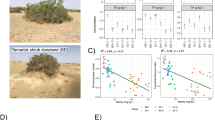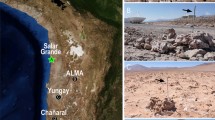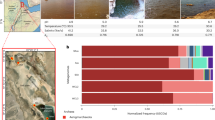Abstract
Microbial communities thriving in hypersaline brines of solar salterns are highly resistant and resilient to environmental changes, and salinity is a major factor that deterministically influences community structure. Here, we demonstrate that this resilience occurs even after rapid osmotic shocks caused by a threefold change in salinity (a reduction from 34 to 12% salts) leading to massive amounts of archaeal cell lysis. Specifically, our temporal metagenomic datasets identified two co-occurring ecotypes within the most dominant archaeal population of the brines Haloquadratum walsbyi that exhibited different salt concentration preferences. The dominant ecotype was generally more abundant and occurred in high-salt conditions (34%); the low abundance ecotype always co-occurred but was enriched at salinities around 20% or lower and carried unique gene content related to solute transport and gene regulation. Despite their apparent distinct ecological preferences, the ecotypes did not outcompete each other presumably due to weak functional differentiation between them. Further, the osmotic shock selected for a temporal increase in taxonomic and functional diversity at both the Hqr. walsbyi population and whole-community levels supporting the specialization-disturbance hypothesis, that is, the expectation that disturbance favors generalists. Altogether, our results provide new insights into how intraspecies diversity is maintained in light of substantial gene-content differences and major environmental perturbations.
Similar content being viewed by others
Log in or create a free account to read this content
Gain free access to this article, as well as selected content from this journal and more on nature.com
or
References
Viver T, Orellana LH, Díaz S, Urdiain M, Ramos‐Barbero MD, González‐Pastor JE, et al. Predominance of deterministic microbial community dynamics in salterns exposed to different light intensities. Environ Microbiol. 2019;21:4300–15.
Tettelin H, Masignani V, Cieslewicz MJ, Donati C, Medini D, Ward NL, et al. Genome analysis of multiple pathogenic isolates of Streptococcus agalactiae: implications for the microbial “pan-genome”. Proc Natl Acad Sci USA. 2005;102:13950–5.
Amann R, Rosselló-Móra R. After all, only millions? MBio. 2016;7:e00999–16.
Konstantinidis KT, Ramette A, Tiedje JM. The bacterial species definition in the genomic era. Philos Trnas R Soc Lond B Biol Sci. 2006;361:1929–40.
Shapiro BJ, Polz MF. Ordering microbial diversity into ecologicaly and genetically cohesive units. Trends Microbiol. 2014;22:235–47.
McInerney JO, McNally A, O’Connell MJ. Why prokaryotes have pangenomes. Nat Microbiol. 2017;2:17040.
Andreani NA, Hesse E, Vos M. Prokaryote genome fluidity is dependent on effective population size. ISMEJ. 2017;11:1719–21.
Cohan FM. What are bacterial species? Annu Rev Microbiol. 2002;56:457–87.
Lan R, Reeves PR. When does a clone deserve a name? A perspective on bacterial species based on population genetics. Trends Microbiol. 2001;9:419–24.
Fraser C, Alm EJ, Polz MF, Spratt BG, Hanage WP. The bacterial species challenge: making sense of genetic and ecological diversity. Science. 2009;323:741–46.
Vázquez DP, Simberloff D. Ecological specialization and susceptibility to disturbance: conjectures and refutations. Am Nat. 2002;159:606–23.
Prosser JI, Bohannan BJM, Curtis TP, Ellis RJ, Firestone MK, Freckleton RP, et al. The role of ecological theory in microbial ecology. Nat Rev Microbiol. 2007;5:384–92.
Shade A, Peter H, Allison SD, Baho DL, Berga M, Bürgmann H, et al. Fundamentals of microbial community resistance and resilience. Front Microbiol. 2012;3:417.
Rodriguez-R LM, Overholt WA, Hagan C, Huettel M, Kostka JE, Konstantinidis KT. Microbial community successional patterns in beach sands impacted by the Deepwater Horizon oil spill. ISME J. 2015;9:1928–40.
Petraitis PS, Latham RE, Niesenbaum RA. The maintenance of species diversity by disturbance. Q Rev Biol. 1989;64:393–418.
Narasingarao P, Podell S, Ugalde JA, Brochier-Armanet C, Emerson JB, Brocks JJ, et al. De novo metagenomic assembly reveals abundant novel major lineage of Archaea in hypersaline microbial communities. ISME J. 2012;6:81–93.
Antón J, Rosselló-Móra R, Rodriguez-Valera F, Amann R. Extremely halophilic bacteria in crystallizer ponds from solar salterns. Appl Environ Microbiol. 2000;66:3052–57.
Gomariz M, Martínez-García M, Santos F, Rodriguez F, Capella-Gutiérrez S, Gabaldón T, et al. From community approaches to single-cell genomics: the Discovery of ubiquitous hyperhalophilic Bacteroidetes generalists. ISME J. 2015;9:1–16.
Mora-Ruiz MR, Font-Verdera F, Díaz-Gil C, Urdiain M, Rodríguez-Valdecantos G, González G, et al. Moderate halophilic bacteria colonizing the phylloplane of halophytes of the subfamily Salicornioideae (Amaranthaceae). Syst Appl Microbiol. 2015;38:406–16.
Antón J, Lucio M, Peña A, Cifuentes A, Brito-Echeverría J, Moritz, F, et al. High metabolomic microdiversity within co-occurring isolates of the extremely halophilic bacterium Salinibacter ruber. PLoS ONE. 2013;8:e64701.
Conrad EC, Viver T, Hatt JK, Rosselló-Móra R, Konstantinidis KT. Unrestricted but ecologically-important gene-content diversity within a natural sequence-discrete population as revealed by sequencing of 112 isolates. 2020. In review.
Cuadros-Orellana S, Martin-Cuadrado AB, Legault B, D’Auria G, Zhaxybayeva O, Papke RT, et al. Genomic plasticity in prokaryotes: the case of the square haloarchaeon. ISME J. 2007;1:235–45.
Konopka A, Lindemann S, Fredrickson J. Dynamics in microbial communities: unraveling mechanisms to identify principles. ISME J. 2015;9:1488–95.
Millán MM, Estrela MJ, Miró J. Rainfall components: variability and spatial distribution in a Mediterranean Area (Valencia Region). J Clim. 2005;18:2682–705.
Santos F, Moreno-Paz M, Meseguer I, López C, Rosselló-Móra R, Parro V, et al. Metatranscriptomic analysis of extremely halophilic viral communities. ISME J. 2011;5:1621–33.
Begon M, Townsend CR, Harper JL, editors. Ecology: from individuals to ecosystems. 4th ed. Malten, MA, USA: Blackwell Publishing Ltd; 2006.
Rodriguez-R LM, Konstantinidis KT. Nonpareil: a redundancy-based approach to assess the level of coverage in metagenomics datasets. Bioinform. 2014;30:629–35.
Ondov BD, Treangen TJ, Melsted P, Mallonee AB, Bergman NH, Koren S, et al. Mash: fast genome and metagenome distance estimation using MinHash. Genome Biol. 2016;17:132.
Oksanen J, Kindt R, Legendre P.O’Hara B. Vegan: community ecology package. Com Ecol Pack. 2007;10:631–37.
Pruesse E, Quast C, Knittel K, Fuchs BM, Ludwig W, Peplies J, et al. SILVA: a comprehensive online resource for quality checked and aligned ribosomal RNA sequence data compatible with ARB. Nucleic Acids Res. 2007;35:7188–96.
Ludwig W, Strunk O, Westram R, Richter L, Meier H, Yadhukumar, et al. ARB; a software environment for sequence data. Nucleic Acids Res. 2004;32:1363–71.
Wu YW, Tang YH, Tringe SG, Simmons BA, Singer SW. MaxBin: an automated binning method to recover individual genomes from metagenomes using an expectation-maximization algorithm. Microbiome. 2014;2:26.
Rodriguez-R LM, Gunturu S, Harvey WT, Rosselló-Móra R, Tiedje JM, Cole JR, et al. The Microbial Genomes Atlas (MiGA) webserver: taxonomic and gene diversity analysis of Archaea and Bacteria at the whole genome level. Nucleic Acids Res. 2018;43:W282–8.
Altschul SF, Gish W, Miller W, Myers EW, Lipman DJ. Basic local alignment search tool. J Mol Biol. 1990;215:403–10.
Eren AM, Esen ÖC, Quince C, Vineis JH, Morrison HG, Sogin ML, et al. Anvi’o: an advanced analysis and visualization platform for ‘omics data. PeerJ. 2015;3:e1319.
Hyatt D, Chen GL, LoCascio PF, Land ML, Larimer FW, Hauser LJ. Prodigal: prokaryotic gene recognition and translation initiation site identification. BMC Bioinform. 2010;11:119.
UniProt Consortium. Uniprot: a hub for protein information. Nucleic Acids Res. 2015;43:D204–12.
Rodriguez-R LM, Konstantinidis KT. The enveomics collection: a toolbox for specialized analyses of microbial genomes and metagenomes. PeerJ Prepr. 2016;4:e1900v1.
Caro-Quintero A, Konstantinidis KT. Bacterial species may exist, metagenomics reveal. Environ Microbiol. 2012;14:347–55.
Goris J, Konstantinidis KT, Klappenbach JA, Coenye T, Vandamme P, Tiedje JM. DNA-DNA hybridization values and their relationship to whole-genome sequence similarities. Int J Syst Evol Microbiol. 2007;57:81–91.
Viver T, Orellana LH, Hatt JK, Urdiain M, Díaz S, Richter M, et al. The low diverse gastric microbiome of the jellyfish Cotylorhiza tuberculata is dominated by four novel taxa. Environ Microbiol. 2017;19:3039–58.
Haynes WM, Lide DR, Bruno TJ, editors. CRC handbook of chemistry and physics, 94th ed. London, UK: CRC Press; 2013. p. 4–89.
Griebler C, Lueders T. Microbial biodiversity in groundwater ecosystems. Freshw Biol. 2009;54:649–77.
Konstantinidis KT, Tiedje JM. Towards a genome-based taxonomy for prokaryotes. J Bacteriol. 2005;187:6258–64.
Oren A. Microbial life at high salt concentrations: phylogenetic and metabolic diversity. Saline Syst. 2008;4:2.
Pedrós-Alió C. Marine microbial diversity: can it be determined? Trends Micribiol. 2006;14:257–63.
Azua-Bustos A, Fairén AG, González-Silva C, Ascaso C, Carrizo D, Fernández-Martínez MÁ, et al. Unprecedented rains decimate surface microbial communities in the hyperarid core of the Atacama Desert. Sci Rep. 2018;8:16706.
Allison SD, Martiny JBH. Resistance, resilience, and redundancy in microbial communities. Proc Natl Acad Sci U S A. 2008;105:11512–19.
Uritskiy G, Getsin S, Munn A, Gomez-Silva B, Davila A, Glass B, et al. Halophilic microbial community compositional shift after a rare rainfall in the Atacama Desert. ISME J. 2019;13:2737–49.
Ghai R, Pašić L, Fernández AB, Martin-Cuadrado AB, Mizuno CM, McMahon KD, et al. New abundant microbial groups in aquatic hypersaline environments. Sci Rep Nat 2011;1:135.
Burns DG, Janssen PH, Itoh T, Minegishi H, Usami R, Kamekura M, et al. Natronomonas moolapensis sp. nov., non-alkaliphilic isolates recovered from a solar saltern crystallizer pond, and emended description of the genus Natronomonas. Int J Syst Evol Microbiol. 2010;60:1173–76.
López-Pérez M, Ghai R, Leon MJ, Rodríguez-Olmos Á, Copa-Patiño JL, Soliveri J, et al. Genomes of “Spiribacter”, a streamlined, successful halophilic bacterium. BMC Genom. 2013;14:787.
Martin-Cuadrado AB, Pašić L, Rodriguez-Valera F. Diversity of the cell-wall associated genomic island of the archaeon Haloquadratum walsbyi. BMC Genom. 2015;16:603.
Mirete S, Mora-Ruiz MF, Lamprecht-Grandío M, de Figueras CG, Rosselló-Móra R, González-Pastor J. Salt resistance genes revealed by functional metagenomics from brines and moderate-salinity rhizosphere within a hypersaline environment. Front Microbiol. 2015;6:1121.
Cray JA, Bell AN, Bhaganna P, Mswaka AY, Timson DJ, Hallsworth JE. The biology of habitat dominance; can microbes behave as weeds? Microb Biotechnol. 2013;6:453–92.
Acknowledgements
The authors would like to thank Arantxa López for DNA extraction and Vladimir Benes for metagenomes sequencing. The authors would especially like to thank the whole team at Salinas d’Es Trenc and Gusto Mundial Balearides, S.L. (Flor de Sal d´Es Trenc) for allowing access to their facilities and their support in performing the experiments. This study was funded by the Spanish Ministry of Economy projects CGL2012-39627-C03-03, CLG2015_66686-C3-1-P and PGC2018-096956-B-C41 (to RRM), CGL2015_66686-C3-3-P (to JA) and also supported with European Regional Development Fund (FEDER) funds. RA was financed by the Max Planck Society. KTK’s research was supported, in part, by the U.S. National Science Foundation (Award No. 1831582). TV received a pre-doctoral fellowship (Nr BES-2013-064420) from the Spanish Government Ministry for Finance and Competition. RRM acknowledges the financial support of the sabbatical stay at Georgia Tech supported by the grant PRX18/00048 of the Ministry of Sciences, Innovation and Universities.
Author information
Authors and Affiliations
Corresponding authors
Ethics declarations
Conflict of interest
The authors declare that they have no conflict of interest.
Additional information
Publisher’s note Springer Nature remains neutral with regard to jurisdictional claims in published maps and institutional affiliations.
Supplementary information
Rights and permissions
About this article
Cite this article
Viver, T., Conrad, R.E., Orellana, L.H. et al. Distinct ecotypes within a natural haloarchaeal population enable adaptation to changing environmental conditions without causing population sweeps. ISME J 15, 1178–1191 (2021). https://doi.org/10.1038/s41396-020-00842-5
Received:
Revised:
Accepted:
Published:
Issue date:
DOI: https://doi.org/10.1038/s41396-020-00842-5
This article is cited by
-
Domain-specific osmoadaptation revealed by metatranscriptomic analysis in hypersaline environments
Scientific Reports (2025)
-
Towards estimating the number of strains that make up a natural bacterial population
Nature Communications (2024)
-
Microbial species and intraspecies units exist and are maintained by ecological cohesiveness coupled to high homologous recombination
Nature Communications (2024)
-
Novel insights into the diversity of halophilic microorganisms and their functioning in hypersaline ecosystems
npj Biodiversity (2024)
-
Deciphering Microbial Adaptation in the Rhizosphere: Insights into Niche Preference, Functional Profiles, and Cross-Kingdom Co-occurrences
Microbial Ecology (2024)



